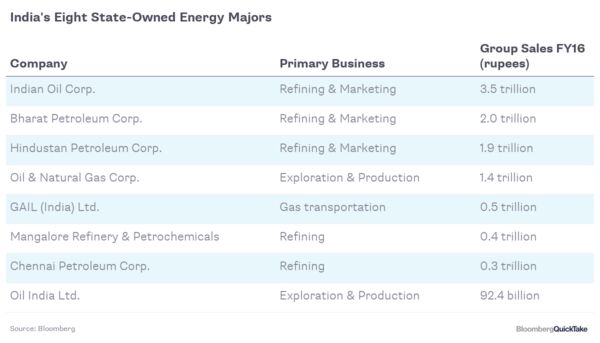Why India Is Creating an Oil and Gas Behemoth: QuickTake Q&A
EghtesadOnline: Big plans are afoot for India’s sprawling hydrocarbons industry. Finance Minister Arun Jaitley says the government aims to create an “integrated public sector oil major” to match the might of the international oil and gas giants.
Details are emerging of how the plan will unfold, according to Bloomberg.
1. What’s the logic?
The government owns majority stakes in eight major listed oil and gas firms. Combining some or all would create a bigger corporation with clout to negotiate better deals, for instance, on crude oil purchases. India imports some 80 percent of its crude needs. A merged business would also be less vulnerable to the vagaries of oil prices by combining producers (which benefit from higher prices) with refiners (which get a boost from lower prices).
2. Just how big are those eight state-owned companies?
Their combined market value is about $112 billion. If folded into one company, that would rank seventh globally among oil and gas majors. (Exxon Mobil Corp. is No. 1 at $337 billion). Such an entity would outstrip India’s private oil giant, Reliance Industries Ltd., whose market value is $67 billion. Six smaller unlisted joint-venture oil and gas companies may also come into play.

3. What has the government said?
Not much, in terms of detail. In August, Oil Minister Dharmendra Pradhan said his ministry was open to discussing a merger to create a larger, stronger national oil company and that the government was figuring out the appropriate model for the combination. Jaitley then spoke in mostly general terms during his Feb. 2 budget speech, about strengthening public-sector enterprises through consolidation, mergers and acquisitions.
4. Where are we now?
According to the Economic Times, the oil ministry, which administers the industry and works independently of the finance ministry, held a meeting in March with the state-run oil companies and asked them to produce a road map for integration. So far, that road map appears to entail a government plan for Oil & Natural Gas Corp. to purchase its 51.1 percent stake in Hindustan Petroleum Corp., worth $4.5 billion.
5. How would that work?
Surprisingly simply. ONGC, India’s biggest explorer, would buy the shares from the government and keep the refiner as a separate subsidiary, obviating the need for an official merger. ONGC already has a refining subsidiary -- adding HPCL would create the nation’s third-largest refiner. India would receive vital funds for reducing the country’s fiscal deficit, though the move would imperil Prime Minister Narendra Modi’s goal of cutting crude imports, since ONGC might need to divert spending from its exploration investments aimed at boosting oil and gas output.
6. Is there a precedent?
The government attempted something similar at least once in the oil sector, during the mid-2000s. Those efforts unraveled through opposition from some of the companies and employees. The proposed deal would also need to surmount the enormous challenge of absorbing refiners with networks across 29 states, thousands of employees and unique work cultures.
7. What about beyond the energy world?
Air India Ltd. has remained unprofitable since its 2007 merger with Indian Airlines Ltd., though it managed to reduce losses this year. The government has struggled to integrate the carriers, failed to achieve the expected synergies and faced labor issues.
8. What do the experts say?
A 2015 study by the Journal of Business Management and Economics concluded that while mergers in India’s energy sector may not create immediate shareholder value, they produce companies that are better placed to compete and adapt. Credit ratings company Fitch Ratings Ltd. drew a similar conclusion.


